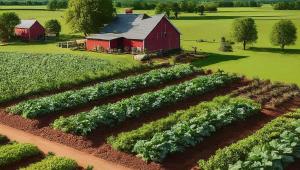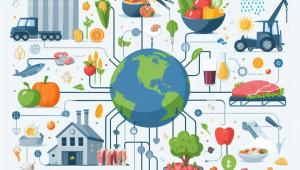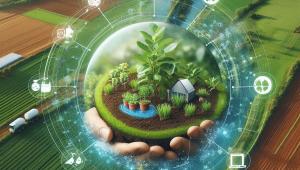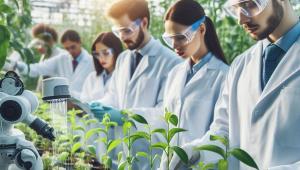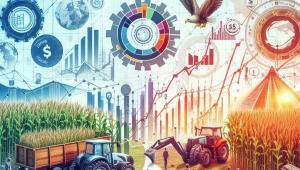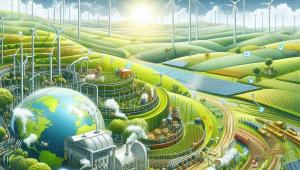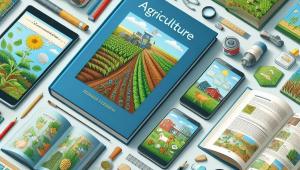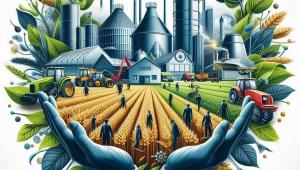Science and technology have played a crucial role in the development and advancement of agriculture throughout history. From the earliest days of human civilization, when hunter-gatherers first began to cultivate crops and domesticate animals, to the modern era of precision agriculture and biotechnology, science and technology have been at the forefront of agricultural innovation.
Basic Agricultural Science
At the foundation of agricultural innovation is basic research in the agricultural sciences, which encompasses a wide range of disciplines, from soil science and plant biology to animal science and agricultural engineering.
Soil Science
Soil science is the study of the physical, chemical, and biological properties of soil, and how these properties influence plant growth and ecosystem function.
Some key areas of research in soil science include:
- Soil formation and classification
- Soil physics, including soil structure, texture, and water-holding capacity
- Soil chemistry, including nutrient cycling and soil pH
- Soil biology, including the role of soil microorganisms in plant growth and soil health
Advances in soil science have led to the development of new techniques for soil management, such as conservation tillage, cover cropping, and precision nutrient management, which can help to improve soil health, reduce erosion, and increase crop yields.
Plant Science
Plant science is the study of the biology, genetics, and physiology of plants, and how these factors influence plant growth, development, and productivity.
Some key areas of research in plant science include:
- Plant genetics and breeding
- Plant physiology and metabolism
- Plant-microbe interactions
- Plant stress responses and adaptation
Advances in plant science have led to the development of new crop varieties with improved traits, such as increased yield, disease resistance, and stress tolerance. Plant scientists are also working to develop new technologies for crop improvement, such as genetic engineering and marker-assisted selection.
Animal Science
Animal science is the study of the biology, behavior, and management of domesticated animals, including livestock and poultry.
Some key areas of research in animal science include:
- Animal genetics and breeding
- Animal nutrition and feed science
- Animal health and disease management
- Animal welfare and behavior
Advances in animal science have led to the development of new technologies for livestock production, such as precision feeding systems, automated milking systems, and advanced breeding techniques. Animal scientists are also working to address key challenges in livestock production, such as reducing greenhouse gas emissions and improving animal welfare.
Agricultural Engineering
Agricultural engineering is the application of engineering principles and design concepts to solve problems in agriculture and food systems.
Some key areas of research in agricultural engineering include:
- Agricultural machinery and equipment design
- Irrigation and water management systems
- Post-harvest handling and storage technologies
- Precision agriculture technologies, such as GPS and remote sensing
Advances in agricultural engineering have led to the development of new tools and technologies for improving the efficiency, sustainability, and productivity of agricultural operations. Agricultural engineers are also working to address key challenges in agriculture, such as reducing energy use and minimizing environmental impacts.
Crop Science and Technology
Crop science and technology encompasses a wide range of research areas and innovations aimed at improving crop production, protection, and utilization. From the development of new crop varieties to the application of precision agriculture technologies, crop science, and technology are at the forefront of efforts to create a more sustainable, resilient, and productive food system.
Crop Breeding and Genetics
Crop breeding and genetics is the science of developing new crop varieties with improved traits, such as higher yield, better quality, and increased resistance to pests and diseases.
Some key areas of research in crop breeding and genetics include:
- Conventional breeding techniques, such as cross-pollination and selection
- Molecular breeding techniques, such as marker-assisted selection and genetic engineering
- Genomics and bioinformatics tools for crop improvement
Advances in crop breeding and genetics have led to the development of new crop varieties with improved traits, such as higher yield, better nutritional quality, and increased resistance to pests and diseases. For example, scientists have developed new varieties of rice that are more resistant to drought and salinity, and new varieties of wheat that are more resistant to fungal diseases.
Crop Protection and Pest Management
Crop protection and pest management is the science of protecting crops from pests, diseases, and other stresses that can reduce yield and quality.
Some key areas of research in crop protection and pest management include:
- Integrated pest management (IPM) strategies that combine biological, cultural, and chemical control methods
- Biopesticides and other natural pest control products
- Disease-resistant crop varieties and cultural practices for disease management
Advances in crop protection and pest management have led to the development of new tools and strategies for reducing crop losses and improving crop health. For example, scientists have developed new biopesticides based on natural plant extracts and beneficial microorganisms, which can provide effective pest control with minimal environmental impact.
Precision Agriculture and Remote Sensing
Precision agriculture and remote sensing technologies are transforming the way that crops are managed and monitored, allowing farmers to optimize inputs, reduce costs, and improve sustainability.
Some key areas of research in precision agriculture and remote sensing include:
- GPS and GIS technologies for mapping and analysis of field variability
- Sensors and imaging systems for monitoring crop health and stress
- Variable rate application technologies for precision input management
Advances in precision agriculture and remote sensing have led to the development of new tools and strategies for improving crop management and reducing environmental impacts. For example, farmers can use GPS-guided machinery to apply fertilizers and pesticides more precisely, reducing waste and minimizing runoff.
Remote sensing technologies, such as drones and satellites, can also provide real-time data on crop health and stress, allowing farmers to make more informed management decisions.
Post-Harvest Technologies and Value Addition
Post-harvest technologies and value addition are critical for ensuring that crops are properly handled, stored, and processed to maintain quality and add value.
Some key areas of research in post-harvest technologies and value addition include:
- Storage and packaging technologies to reduce spoilage and extend shelf life
- Processing technologies to create value-added products, such as snacks, beverages, and ingredients
- Quality control and safety testing technologies to ensure product quality and safety
Advances in post-harvest technologies and value addition have led to the development of new products and markets for agricultural commodities. For example, scientists have developed new packaging materials that can extend the shelf life of fresh produce, reducing food waste and increasing market access for smallholder farmers. Value-added processing technologies, such as extrusion and fermentation, can also create new products and ingredients from agricultural commodities, such as plant-based proteins and functional foods.
Livestock Science and Technology
Livestock science and technology encompasses a wide range of research areas and innovations aimed at improving the efficiency, sustainability, and animal welfare of livestock production systems. From the development of new feed additives and vaccines to the application of precision livestock farming technologies, livestock science, and technology are at the forefront of efforts to meet the growing global demand for animal protein while minimizing environmental impacts and ensuring animal welfare.
Animal Breeding and Genetics
Animal breeding and genetics is the science of developing new livestock breeds and lines with improved traits, such as higher productivity, better feed efficiency, and increased disease resistance.
Some key areas of research in animal breeding and genetics include:
- Quantitative genetics and genomic selection for livestock improvement
- Transgenic and genome editing technologies for targeted trait improvement
- Conservation and utilization of animal genetic resources
Advances in animal breeding and genetics have led to the development of new livestock breeds and lines with improved traits, such as higher milk yield in dairy cows, faster growth rates in beef cattle, and increased disease resistance in poultry. For example, scientists have used genomic selection to develop new lines of pigs with improved feed efficiency and meat quality, reducing the environmental impact of pork production.
Animal Nutrition and Feed Science
Animal nutrition and feed science is the study of the nutritional requirements of livestock and the development of new feed ingredients and additives to improve animal health and productivity.
Some key areas of research in animal nutrition and feed science include:
- Nutrient requirements and feed formulation for different livestock species and life stages
- Alternative feed ingredients, such as by-products and novel protein sources
- Feed additives, such as probiotics, enzymes, and organic acids, to improve feed efficiency and gut health
Advances in animal nutrition and feed science have led to the development of new feed ingredients and additives that can improve animal health and productivity while reducing feed costs and environmental impacts. For example, scientists have developed new feed additives based on plant extracts and essential oils that can improve gut health and reduce the use of antibiotics in livestock production.
Animal Health and Disease Management
Animal health and disease management is the science of preventing, diagnosing, and treating diseases in livestock and ensuring the safety and quality of animal products.
Some key areas of research in animal health and disease management include:
- Vaccine development and delivery technologies for disease prevention
- Diagnostic technologies for rapid and accurate disease detection
- Antimicrobial resistance and alternative disease control strategies
Advances in animal health and disease management have led to the development of new vaccines, diagnostics, and disease control strategies that can improve animal health and reduce the use of antibiotics in livestock production. For example, scientists have developed new vaccines based on recombinant DNA technology that can protect against multiple diseases with a single dose.
Precision Livestock Farming
Precision livestock farming (PLF) technologies are transforming the way that livestock are managed and monitored, allowing farmers to optimize production, reduce costs, and improve animal welfare.
Some key areas of research in PLF include:
- Sensors and imaging systems for monitoring animal health, behavior, and productivity
- Automated feeding and milking systems for improved efficiency and animal welfare
- Big data analytics and decision support tools for optimizing livestock management
Advances in PLF technologies have led to the development of new tools and strategies for improving the efficiency and sustainability of livestock production. For example, farmers can use wearable sensors to monitor the health and behavior of individual animals, allowing for early detection and treatment of diseases. Automated feeding and milking systems can also improve the efficiency and consistency of livestock management while reducing labor requirements.
Aquaculture and Fisheries Science and Technology
Aquaculture and fisheries science and technology encompasses a wide range of research areas and innovations aimed at improving the sustainability, productivity, and profitability of aquatic food systems. From the development of new feed ingredients and disease control strategies to the application of advanced breeding and production technologies, aquaculture and fisheries science and technology are at the forefront of efforts to meet the growing global demand for seafood while minimizing environmental impacts and ensuring social and economic benefits.
Aquaculture Production Systems
Aquaculture production systems are the methods and technologies used to grow and harvest aquatic animals and plants in controlled environments, such as ponds, tanks, and cages.
Some key areas of research in aquaculture production systems include:
- Recirculating aquaculture systems (RAS) for land-based fish production
- Offshore and open ocean aquaculture systems for marine fish and shellfish production
- Integrated multi-trophic aquaculture (IMTA) systems for sustainable nutrient cycling
Advances in aquaculture production systems have led to the development of new technologies and practices that can improve the efficiency, sustainability, and profitability of aquaculture operations. For example, RAS technologies can reduce water use and waste discharge while providing a controlled environment for fish growth and health. IMTA systems can also improve the sustainability of aquaculture by recycling nutrients and reducing waste.
Aquaculture Breeding and Genetics
Aquaculture breeding and genetics is the science of developing new strains and varieties of aquatic animals and plants with improved traits, such as faster growth rates, disease resistance, and product quality.
Some key areas of research in aquaculture breeding and genetics include:
- Selective breeding and hybridization for improved production traits
- Marker-assisted selection and genomic selection for targeted trait improvement
- Genetic conservation and management of aquatic genetic resources
Advances in aquaculture breeding and genetics have led to the development of new strains and varieties of fish and shellfish with improved production traits. For example, scientists have used selective breeding to develop new strains of tilapia with faster growth rates and improved disease resistance, reducing production costs and improving profitability for small-scale farmers.
Aquaculture Nutrition and Feed Technology
Aquaculture nutrition and feed technology is the study of the nutritional requirements of aquatic animals and the development of new feed ingredients and formulations to improve growth, health, and product quality.
Some key areas of research in aquaculture nutrition and feed technology include:
- Alternative protein sources, such as plant-based and insect-based ingredients
- Functional feed additives, such as probiotics, prebiotics, and immunostimulants
- Feed processing and delivery technologies for improved efficiency and sustainability
Advances in aquaculture nutrition and feed technology have led to the development of new feed ingredients and formulations that can improve the efficiency and sustainability of aquaculture production. For example, scientists have developed new plant-based protein sources, such as algae and duckweed, that can replace fishmeal in aquaculture feeds, reducing the environmental impact of feed production.
Fisheries Science and Management
Fisheries science and management is the study of wild fish populations and the development of strategies and policies for sustainable fisheries management.
Some key areas of research in fisheries science and management include:
- Stock assessment and population dynamics modeling for fisheries management
- Ecosystem-based fisheries management for sustainable resource use
- Bycatch reduction and selectivity technologies for minimizing environmental impacts
Advances in fisheries science and management have led to the development of new tools and strategies for sustainable fisheries management, such as ecosystem-based approaches that consider the interactions between fish populations, habitats, and human activities. For example, scientists have developed new bycatch reduction devices, such as turtle excluder devices (TEDs) and selective fishing gear, that can reduce the incidental capture of non-target species in fisheries.
Food Science and Technology
Food science and technology encompasses a wide range of research areas and innovations aimed at improving the safety, quality, and sustainability of food products and processes. From the development of new food ingredients and processing technologies to the application of advanced analytical and sensory techniques, food science and technology are at the forefront of efforts to meet the evolving needs and preferences of consumers while ensuring a safe, nutritious, and sustainable food supply.
Food Processing and Preservation
Food processing and preservation technologies are the methods and techniques used to transform raw agricultural commodities into safe, stable, and convenient food products.
Some key areas of research in food processing and preservation include:
- Thermal processing technologies, such as pasteurization and sterilization, for microbial inactivation
- Non-thermal processing technologies, such as high-pressure processing and pulsed electric fields, for minimal processing and quality retention
- Advanced packaging technologies, such as modified atmosphere packaging and active packaging, for shelf-life extension
Advances in food processing and preservation technologies have led to the development of new food products and processes that can improve food safety, quality, and convenience. For example, high-pressure processing can inactivate harmful microorganisms while retaining the nutritional and sensory quality of foods, providing a safe and natural alternative to chemical preservatives.
Food Chemistry and Analysis
Food chemistry and analysis is the study of the chemical composition and properties of foods and the development of analytical methods and techniques for measuring food quality and safety.
Some key areas of research in food chemistry and analysis include:
- Chemical and biochemical reactions in foods, such as Maillard browning and lipid oxidation
- Advanced analytical techniques, such as mass spectrometry and nuclear magnetic resonance, for food authentication and quality assessment
- Rapid and non-destructive methods for food safety and quality monitoring
Advances in food chemistry and analysis have led to the development of new tools and techniques for ensuring the safety, quality, and authenticity of food products. For example, scientists have developed new rapid and non-destructive methods, such as infrared spectroscopy and electronic noses, that can detect food contaminants and spoilage in real-time, reducing the risk of foodborne illness and food waste.
Food Microbiology and Safety
Food microbiology and safety is the study of the microorganisms that affect food quality and safety and the development of strategies and technologies for controlling microbial growth and contamination.
Some key areas of research in food microbiology and safety include:
- Pathogen detection and identification methods for food safety monitoring
- Microbial inactivation technologies, such as irradiation and ultrasound, for food preservation
- Probiotic and prebiotic technologies for promoting gut health and immunity
Advances in food microbiology and safety have led to the development of new tools and strategies for ensuring the safety and quality of food products. For example, scientists have developed new rapid and sensitive methods for detecting foodborne pathogens, such as PCR and immunoassays, that can help to prevent outbreaks of foodborne illness. Probiotic and prebiotic technologies can also promote the growth of beneficial gut bacteria, enhancing human health and well-being.
Food Sensory Science and Consumer Behavior
Food sensory science and consumer behavior is the study of how people perceive and respond to the sensory properties of foods and the development of methods and techniques for measuring and optimizing food quality and acceptance.
Some key areas of research in food sensory science and consumer behavior include:
- Sensory evaluation methods, such as descriptive analysis and consumer testing, for measuring food quality and acceptance
- Consumer behavior and preference modeling for food product development and marketing
- Sensory-driven product design and optimization for improved consumer satisfaction
Advances in food sensory science and consumer behavior have led to the development of new tools and techniques for understanding and improving the sensory quality and consumer acceptance of food products. For example, scientists have developed new sensory evaluation methods, such as temporal dominance of sensations and check-all-that-apply, that can provide more detailed and reliable insights into consumer preferences and perceptions.
Consumer behavior modeling and sensory-driven product design can also help food companies develop and market products that meet the evolving needs and preferences of consumers.
Environmental Science and Sustainability
Environmental science and sustainability are critical considerations in the development and application of agricultural science and technology. From the assessment and mitigation of environmental impacts to the development of sustainable agricultural practices and technologies, environmental science and sustainability are at the forefront of efforts to create a more resilient, equitable, and sustainable food system.
Environmental Impact Assessment and Mitigation
Environmental impact assessment and mitigation is the process of identifying, quantifying, and managing the environmental impacts of agricultural activities and technologies.
Some key areas of research in environmental impact assessment and mitigation include:
- Life cycle assessment (LCA) for measuring the environmental impacts of agricultural products and processes
- Environmental risk assessment for evaluating the potential risks and benefits of new agricultural technologies
- Best management practices (BMPs) for reducing the environmental impacts of agricultural activities, such as nutrient management and conservation tillage
Advances in environmental impact assessment and mitigation have led to the development of new tools and strategies for reducing the environmental footprint of agriculture. For example, LCA can help to identify hotspots of environmental impact in the food supply chain, informing targeted interventions and innovations for sustainability.
BMPs, such as precision agriculture and integrated pest management, can also reduce the use of inputs and minimize environmental impacts while maintaining or improving agricultural productivity.
Sustainable Agriculture and Agroecology
Sustainable agriculture and agroecology are holistic approaches to agriculture that seek to optimize the social, economic, and environmental dimensions of food systems.
Some key areas of research in sustainable agriculture and agroecology include:
- Agroecological principles and practices, such as intercropping, agroforestry, and conservation agriculture, for enhancing biodiversity and ecosystem services
- Participatory research and co-innovation with farmers and communities for developing locally adapted and socially acceptable solutions
- Sustainable intensification strategies for increasing agricultural productivity while minimizing environmental impacts and enhancing social and economic benefits
Advances in sustainable agriculture and agroecology have led to the development of new approaches and technologies for creating more resilient, equitable, and sustainable food systems. For example, agroecological practices, such as cover cropping and reduced tillage, can improve soil health, reduce erosion, and enhance carbon sequestration.
Participatory research and co-innovation can also empower farmers and communities to develop and adopt sustainable practices that are tailored to their specific needs and contexts.
Climate-Smart Agriculture and Resilience
Climate-smart agriculture (CSA) and resilience are approaches to agriculture that seek to adapt to and mitigate the impacts of climate change while enhancing food security and livelihoods.
Some key areas of research in CSA and resilience include:
- Climate risk assessment and adaptation planning for identifying and prioritizing climate risks and adaptation options
- Climate-resilient crop varieties and livestock breeds for enhancing the adaptive capacity of agricultural systems
- Low-emission agricultural practices and technologies, such as precision agriculture and anaerobic digestion, for reducing greenhouse gas emissions and enhancing carbon sequestration
Advances in CSA and resilience have led to the development of new tools and strategies for creating more resilient and sustainable food systems in the face of climate change. For example, climate risk assessment and adaptation planning can help farmers and policymakers identify and prioritize adaptation options, such as drought-tolerant crops and water-saving technologies. Low-emission agricultural practices and technologies can also reduce the carbon footprint of agriculture while enhancing productivity and profitability.
Ecosystem Services and Biodiversity Conservation
Ecosystem services and biodiversity conservation are critical considerations in the development and application of agricultural science and technology.
Some key areas of research in ecosystem services and biodiversity conservation include:
- Agroecosystem modeling and valuation for quantifying the economic and ecological value of ecosystem services, such as pollination and nutrient cycling
- Agrobiodiversity conservation and use for enhancing the resilience and sustainability of agricultural systems
- Landscape-level approaches to agriculture and conservation for optimizing the provision of ecosystem services and biodiversity conservation
Advances in ecosystem services and biodiversity conservation have led to the development of new approaches and technologies for creating more diverse, resilient, and multifunctional agricultural landscapes. For example, agroecosystem modeling and valuation can help to quantify the economic and ecological benefits of ecosystem services, informing land use planning and policy decisions.
Agrobiodiversity conservation and use can also enhance the resilience and sustainability of agricultural systems by providing a diverse pool of genetic resources and ecological functions.
Social and Economic Dimensions
The social and economic dimensions of agricultural science and technology are critical considerations in the development and application of innovations for sustainable and equitable food systems. From the assessment of social and economic impacts to the development of inclusive and participatory approaches, social and economic research is at the forefront of efforts to create a more just and sustainable food system.
Social Impact Assessment and Equity
Social impact assessment and equity are critical considerations in the development and application of agricultural science and technology.
Some key areas of research in social impact assessment and equity include:
- Distributional impacts of agricultural technologies and policies on different social groups, such as women, youth, and marginalized communities
- Participatory impact assessment methods for engaging stakeholders in the evaluation and design of agricultural innovations
- Equity and justice considerations in the development and dissemination of agricultural technologies and knowledge
Advances in social impact assessment and equity have led to the development of new approaches and tools for creating more inclusive and equitable food systems. For example, participatory impact assessment methods can empower communities to identify and prioritize their needs and priorities, informing the design and implementation of agricultural innovations.
Equity and justice considerations can also guide the development and dissemination of agricultural technologies and knowledge, ensuring that the benefits of innovation are shared equitably among all stakeholders.
Agricultural Economics and Policy
Agricultural economics and policy are critical considerations in the development and application of agricultural science and technology. Some key areas of research in agricultural economics and policy include:
- Economic impact assessment of agricultural technologies and policies on farm profitability, market access, and rural development
- Policy analysis and design for creating enabling environments for sustainable and equitable agricultural development
- Value chain analysis and development for enhancing the competitiveness and sustainability of agricultural markets
Advances in agricultural economics and policy have led to the development of new approaches and tools for creating more efficient, competitive, and sustainable agricultural markets and policies. For example, economic impact assessment can help to quantify the costs and benefits of agricultural technologies and policies, informing investment and policy decisions. Policy analysis and design can also create enabling environments for sustainable and equitable agricultural development, such as through the promotion of sustainable agricultural practices and the creation of inclusive value chains.
Extension and Knowledge Management
Extension and knowledge management are critical considerations in the development and application of agricultural science and technology.
Some key areas of research in extension and knowledge management include:
- Participatory extension approaches, such as farmer field schools and community-based extension, empower farmers and communities to adopt and adapt sustainable agricultural practices
- Knowledge management systems and platforms for facilitating the sharing and exchange of agricultural knowledge and innovations
- Capacity building and training for enhancing the skills and competencies of agricultural stakeholders, such as farmers, extensionists, and researchers
Advances in extension and knowledge management have led to the development of new approaches and tools for creating more effective and inclusive agricultural knowledge and innovation systems. For example, participatory extension approaches can empower farmers and communities to identify and prioritize their knowledge needs, informing the design and delivery of extension services.
Knowledge management systems and platforms can also facilitate the sharing and exchange of agricultural knowledge and innovations, enhancing the uptake and impact of sustainable agricultural practices.
Conclusion
Agricultural science and technology have played a critical role in the development and advancement of agriculture throughout history and will continue to be essential for creating a more sustainable, resilient, and equitable food system in the face of global challenges such as climate change, population growth, and resource scarcity.
From basic research in the agricultural sciences to the development and application of new tools, techniques, and technologies, agricultural science and technology are at the forefront of efforts to optimize crop and livestock production, enhance food safety and quality, and minimize environmental impacts. Advances in areas such as precision agriculture, biotechnology, and food processing are creating new opportunities for innovation and growth in the agricultural sector, while also raising important questions about the social, economic, and ethical implications of these technologies.
To ensure that the benefits of agricultural science and technology are realized sustainably and equitably, it is essential to adopt a holistic and interdisciplinary approach that considers the complex interplay of biophysical, social, and economic factors in agricultural systems. This requires the active engagement and participation of all stakeholders, including farmers, researchers, policymakers, and consumers, in the co-design and co-implementation of agricultural innovations.
Furthermore, it is critical to prioritize the needs and aspirations of small-scale farmers, women, and marginalized communities, who are often the most vulnerable to the impacts of climate change and other global challenges. This requires a shift towards more inclusive, participatory, and gender-responsive approaches to agricultural research and development, as well as the creation of enabling policies and institutions that support the adoption and scaling of sustainable agricultural practices.
Ultimately, the success of agricultural science and technology in creating a more sustainable and equitable food system will depend on our ability to harness the power of innovation while also addressing the underlying social, economic, and political factors that shape the food system. This will require a collaborative and integrated approach that brings together the expertise and perspectives of different disciplines and stakeholders, from the natural and social sciences to the private sector and civil society.
By working together to develop and apply agricultural science and technology responsibly and equitably, we can create a food system that nourishes both people and the planet, and that provides a foundation for sustainable and inclusive economic growth and development. This is a critical challenge and opportunity for our time, and one that demands the best of our scientific knowledge, technological ingenuity, and social and ethical commitment.
